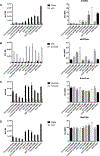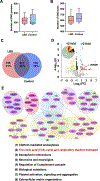S-Nitrosylation-mediated dysfunction of TCA cycle enzymes in synucleinopathy studied in postmortem human brains and hiPSC-derived neurons
- PMID: 37478858
- PMCID: PMC10530441
- DOI: 10.1016/j.chembiol.2023.06.018
S-Nitrosylation-mediated dysfunction of TCA cycle enzymes in synucleinopathy studied in postmortem human brains and hiPSC-derived neurons
Abstract
A causal relationship between mitochondrial metabolic dysfunction and neurodegeneration has been implicated in synucleinopathies, including Parkinson disease (PD) and Lewy body dementia (LBD), but underlying mechanisms are not fully understood. Here, using human induced pluripotent stem cell (hiPSC)-derived neurons with mutation in the gene encoding α-synuclein (αSyn), we report the presence of aberrantly S-nitrosylated proteins, including tricarboxylic acid (TCA) cycle enzymes, resulting in activity inhibition assessed by carbon-labeled metabolic flux experiments. This inhibition principally affects α-ketoglutarate dehydrogenase/succinyl coenzyme-A synthetase, metabolizing α-ketoglutarate to succinate. Notably, human LBD brain manifests a similar pattern of aberrantly S-nitrosylated TCA enzymes, indicating the pathophysiological relevance of these results. Inhibition of mitochondrial energy metabolism in neurons is known to compromise dendritic length and synaptic integrity, eventually leading to neuronal cell death. Our evidence indicates that aberrant S-nitrosylation of TCA cycle enzymes contributes to this bioenergetic failure.
Copyright © 2023 Elsevier Ltd. All rights reserved.
Conflict of interest statement
Declaration of interests The authors declare no competing interests.
Figures




References
-
- Cooper O, Seo H, Andrabi S, Guardia-Laguarta C, Graziotto J, Sundberg M, McLean JR, Carrillo-Reid L, Xie Z, Osborn T, et al. (2012). Pharmacological rescue of mitochondrial deficits in iPSC-derived neural cells from patients with familial Parkinson’s disease. Sci. Transl. Med. 4, 141ra190. 10.1126/scitranslmed.3003985. - DOI - PMC - PubMed
-
- Ryan SD, Dolatabadi N, Chan SF, Zhang X, Akhtar MW, Parker J, Soldner F, Sunico CR, Nagar S, Talantova M, et al. (2013). Isogenic human iPSC Parkinson’s model shows nitrosative stress-induced dysfunction in MEF2-PGC1α transcription. Cell 155, 1351–1364. 10.1016/j.cell.2013.11.009. - DOI - PMC - PubMed
Publication types
MeSH terms
Grants and funding
- R01 AG061845/AG/NIA NIH HHS/United States
- R35 AG071734/AG/NIA NIH HHS/United States
- R01 AG078756/AG/NIA NIH HHS/United States
- P30 AG062429/AG/NIA NIH HHS/United States
- RF1 NS123298/NS/NINDS NIH HHS/United States
- DP1 DA041722/DA/NIDA NIH HHS/United States
- U01 AG088679/AG/NIA NIH HHS/United States
- R56 AG065372/AG/NIA NIH HHS/United States
- R61 NS122098/NS/NINDS NIH HHS/United States
- R01 AG056259/AG/NIA NIH HHS/United States
- R01 NS123298/NS/NINDS NIH HHS/United States
- R01 DA048882/DA/NIDA NIH HHS/United States
- RF1 AG057409/AG/NIA NIH HHS/United States
LinkOut - more resources
Full Text Sources
Medical
Molecular Biology Databases

